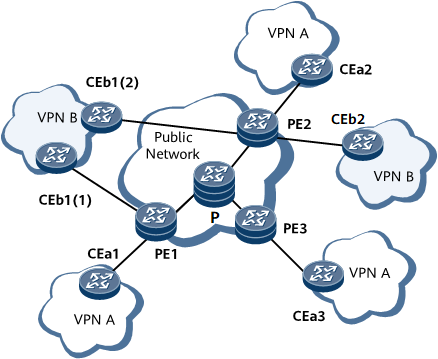Application Scenarios for Multicast
Introduction to Multi-Instance Multicast
Multi-instance multicast is the basis of transmitting multicast data across VPNs. Multi-instance multicast applies to IPv4 VPNs.
A VPN needs to be separated from a public network and also from other VPNs. As shown in Figure 1, VPN A and VPN B are isolated yet connected to the public network through provider edge (PE) devices.
On this network:
P belongs to the public network. Each customer edge (CE) device belongs to a VPN. Each router is dedicated to a network and maintains only one forwarding mechanism.
PEs are connected to both the public network and one or more VPN networks. The network information must be completely separated, and a separate set of forwarding mechanism needs to be maintained for each network. The set of software and hardware device that serves the same network on the PE is called an instance. A PE supports multiple instances, and one instance can reside on multiple PEs.

For details of the multi-instance multicast technique, see the HUAWEI NetEngine 8000 F Series RouterFeature Description - VPN.
Applications of Multi-Instance Multicast
Multi-instance multicast implements the following functions for PEs:
Maintains a separate multicast forwarding mechanism for each instance. A forwarding mechanism supports all multicast protocols and maintains a PIM neighbor list and a multicast routing table. Each instance searches its own forwarding table or routing table when forwarding multicast data.
Isolates instances from each other.
Implements communication and data exchange between a public network instance and a VPN instance.
